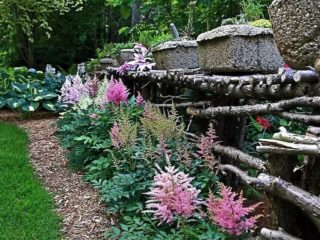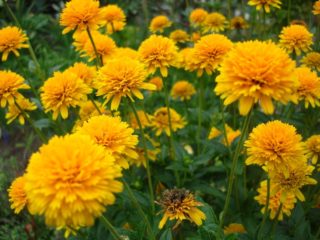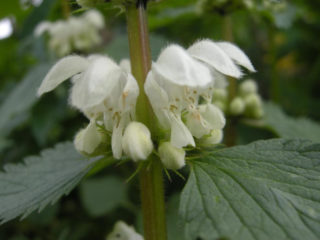Content
- 1 The history of the origin of peony Elsa Sass
- 2 Description and characteristics of peony Elsa Sass
- 3 Advantages and disadvantages
- 4 Landing rules
- 5 Care instructions
- 6 Reproduction methods
- 7 Disease and pest control
- 8 Application in landscape design
- 9 Conclusion
- 10 Reviews from gardeners about peony Elsa Sass
Peony Elsa Sass is a great addition to any flower garden. Due to its appearance, aroma and simple care procedures, the flower has already won the hearts of many gardeners around the world. Peony is actively used in landscape design as a main element or in combination with other plants. Elsa Sass is unpretentious to changes in temperature and humidity, so it can easily exist in any garden.
The history of the origin of peony Elsa Sass
The life of the peony Elsa Sass began not so long ago. Breeding work started back in the 20s of the last century. The first representative was obtained in 1930 thanks to the work of the Dutch breeder Henry Sass. After some time, the already strong plants received the APO gold medal. The peony got its name for a reason. Henry Sass completed the work in honor of his wife, Elsa. This is how the story of the popular representative of beautiful peonies began.
Description and characteristics of peony Elsa Sass
Experts classify them as herbaceous plants.The stem has a thick and strong structure. The height of the shoot is average - some representatives reach up to 90 cm. Around the flower the bushes are erect with a large number of leaves. A large bud needs a strong frame, so the stem can withstand strong wind, snow and even trampling.
Peony petals are characterized as double and pink-shaped.

The diameter of the buds can reach 18 cm
The color is usually creamy white. There are also plants with a small edging of petals around the edges. This is typical for young plants. With age, the entire surface of the flower becomes white. The shape of the petal is correct; on the upper part of the peony there are pronounced stamens - the reproductive organ.
The color also includes yellow. It is located in the middle of the bud, in the place where the stamens are. As you move away from the center, the gradient of yellow and white mixes and smoothly flows into each other. Towards the end points of the petals, the entire surface is presented in white.
In addition to the visual effect, the Elsa Sass peony also affects the olfactory receptors. Any garden will have an incredible aroma when this seedling appears in it. The degree of smell is average, but there is a characteristic honey aftertaste.
Flowering dates for peony Elsa Sass
Flowering occurs late in the summer. The buds usually open from June to July. This period does not last long, so peony lovers need time to enjoy the incredible beauty of the plant. In no more than 5-6 weeks you can watch the petals bloom and feel the wonderful aroma.
Advantages and disadvantages
Peony Elsa Sass is loved by many. But, like many plants, peonies have both disadvantages and advantages.

Elsa Sass peonies look very beautiful in bouquet arrangements
Pros:
- aesthetic appearance;
- high shear resistance;
- pleasant unobtrusive aroma;
- sufficient resistance to drought;
- large bud sizes;
- combination with different color schemes in the flowerbed and in the bouquet;
- strong stems that provide increased stability for a large flower;
- sufficient degree of frost resistance;
- good immunity to diseases and pests.
Minuses:
- Elsa Sass peonies prefer soil with a mineral composition and sufficient fertilizer;
- watering should be carried out only in the prescribed volume according to a certain schedule;
- seedlings or ready-made bouquets are quite expensive.
Landing rules
One of the main criteria for the successful life of a plant is the choice of planting date. The optimal period for Elsa Sass peonies is the end of spring, the beginning of summer or the first days of autumn. It is at this time that the temperature is mild, without severe frosts and heat. The amount of light doesn't matter either. Peonies will feel great both in the shade and in the sun.
The root system of the plant is quite extensive, therefore, for the comfortable existence of several representatives in one bed, it is recommended to leave 70-80 cm between adjacent stems.

Loamy soil is ideal for the development of healthy flowers.
The acidity should be neutral. Such soil contains a large number of microelements important for development. In addition, peony takes root in such soil much faster.
Care instructions
The main rule of proper care is regularity. The future life of not only one unit, but also the entire bed depends on its duration and quality.
When caring for the plant, special attention should be paid to watering. Although peonies are quite drought tolerant, they still like moist soil.Each plant needs to be moistened individually. They calculate it this way: several buckets per representative.
Feeding also plays a significant role. Competent gardeners use only the foliar form in the first year of a flower’s life. In subsequent years, it is necessary to carry out a full complex. It is recommended to feed three times during the season.
Peonies love fresh air. Experts advise limiting Elsa Sass's contact with trees, buildings or other plants.
Preparing for winter
Peonies are frost-resistant representatives. Despite this, gardeners should prepare their plants for winter. It is necessary to feed the soil so that the plant can receive useful minerals. The soil should be moist. Gardeners often wrap the lower part of the shoot with a warm piece of fabric. This helps avoid freezing.
Reproduction methods
There are a large number of methods for crossing and producing peony offspring. The most popular of them are cuttings and dividing the bush.
Cutting means cutting off a small shoot - a cutting - from the body of the mother specimen. Experts advise carrying out the process in the summer.
The method of dividing a bush is much more complicated. Requires high professionalism and accuracy when working with separated plants. Gardeners recommend starting the process in the fall.
Disease and pest control
Peony Elsa Sass is a cultivated plant. It was grown artificially, thanks to the great work of a team of professional breeders. Scientists have endowed him with strong immunity to diseases and insects.
Although the plant is more resistant than others, cases of infection and even death of these flowers are not uncommon. The most common diseases include rust and gray rot. A characteristic feature of the problem is the rapid spread to neighboring flowers.That is why it is worth trimming the affected areas and isolating them from the flower bed. Seedlings are treated with Horus, Skor, Revus.
Insects also love to spoil the beautiful appearance of peonies. The most famous pests - ants, aphids, bronze beetles - respond to strong insecticidal agents (Fufanon, Karbofos, Fitoverm).
Application in landscape design

A small bush of white peonies will decorate any area
Peonies can transform any garden.

Due to the large buds, long stem and incredible aroma, the flowers fit perfectly into any landscape design, especially with other types of peonies.
Many gardeners also decorate their flower beds with various figures and figurines, which adds a special touch.

Professional designers and florists use Elsa Sass for decorative purposes.
Flowers stand well in holiday bouquets or in interior vases on the coffee table.
Conclusion
Peony Elsa Sass is a unique plant. Due to its appearance and low maintenance it deserves a special place in any garden. Widely used in the field of floristry and landscape design.
Reviews from gardeners about peony Elsa Sass








